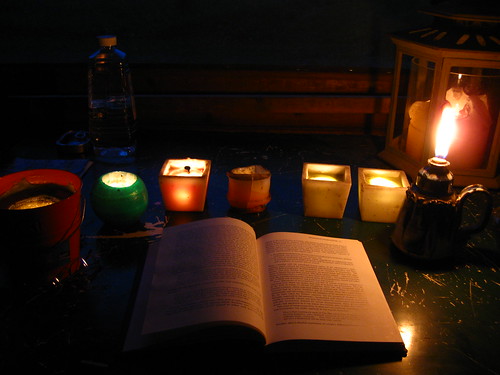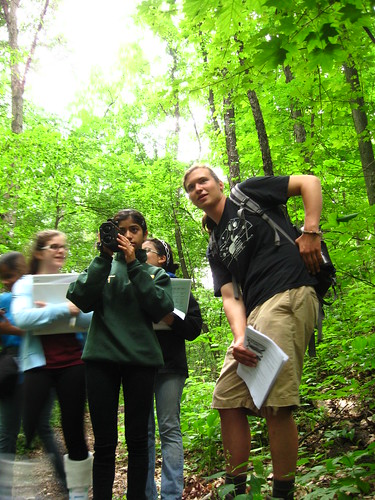The major storms that came through Washtenaw County on Wednesday night brought rain, lightning, and two confirmed tornadoes. While no tornadoes hit Saginaw Forest (this is an assumption, due to the lack of additional downed trees after the storm), an unlucky lightning strike shut off the power to the cabin at about 10:30PM.
None of the breakers tripped, and none of the powerstrips flipped off. However, my computer was one of the electronics that shut off. Maybe it was my imagination, but when I sniffed the outlet fan, there was a fain whiff of burnt electronics. Hopefully it
was my imagination (especially since I have not been having problems with the computer at the current time).
On Thursday morning, I walked the length of the wires, to see if there was any obvious sign of the power outage (i.e., if a power line had been taken out by a fallen tree). However, I didn't see anything that spoke to me of a problem. However, the neighbors all had power, so it
had to be something about the lines going in to Saginaw Forest (or the transformer on the property). I called it in, and was told that I
should be taken care of by 11:45PM that night. (Now, I know that the property is probably not too high on people's lists, and that there were several outages throughout Washtenaw, but I was still surprised that it might not be fixed for more than 24 hours after the outage.)
At 3:40PM, just as I was about to give a call to DTE, my phone rang. It was U-M DPS calling me to say that their parking enforcement unit at the front gate was reporting that there was a DTE van wanting to get onto the property. Wow! I went up to meet the van, and the man also walked the lines and checked the power condition at the electrical box. He didn't spot anything on the property, and confirmed that the power was still off, but (because he wasn't a line-man), couldn't do more than that, but did forward the ticket for the line-men to take care of, but he, too, couldn't give an estimated time.

I took off for a meeting in town, and then returned at some point around 7PM. Then, I sat out on the porch, reading books by the diminishing light of the sun. Around 9:15PM, I heard some people walking down the road, and looked up to see four men with white hard-hats. The DTE line-men. I walked them out, along the lines, and they, too, confirmed that it wasn't anything on the property, but then continued to walk along the line onto the adjoining property. There, they noted that there was one
fuse cut-out that had
busted open on the line. It was something that I
did see in the morning, but didn't know to make a note of it. Now that I know one more thing to look for, I will note it in future line walks post-power outages.
However, although the power was soon returned, I soon realized that the DSL and phone was not working. After calling AT&T (and working through the automated systems), I got to an operator, who submitted a ticket. Since it was already 11:30PM, however, I decided to just go to sleep, since it was unlikely that anyone would come out at that time of night.
In the morning, I called AT&T again, and was told that (for some reason), the ticket wouldn't have any work until Sunday! Then the operator noted that it was a University of Michigan account that she was dealing with, and bumped me up to today. While in town, I got a call from the technician who told me that there
was a signal, at least to the outside of the cabin. Perhaps there is a problem with the DSL/telephone splitter/filter. Perhaps there was a problem with the wire going into the cabin. Perhaps, too, there was a problem with the DSL modem. However, if they were going to do any work
inside the cabin (including replacing the cable coming into the cabin), it would cost $71 for a call-out, $25 per quarter-hour, and probably an additional $5-$10 for parts, and recommended against having him cross the threshold, unless it was absolutely necessary. Given those prices, I had to agree with him.





